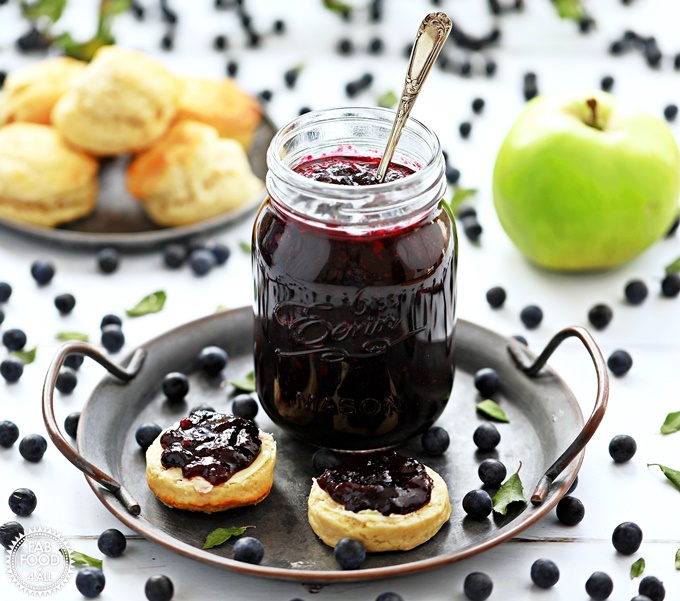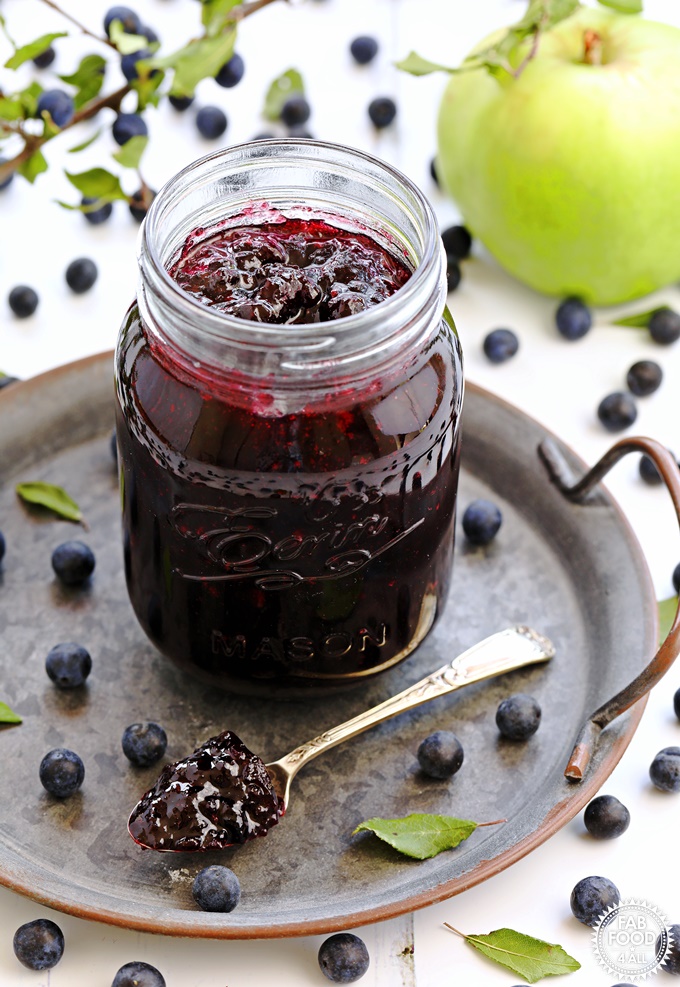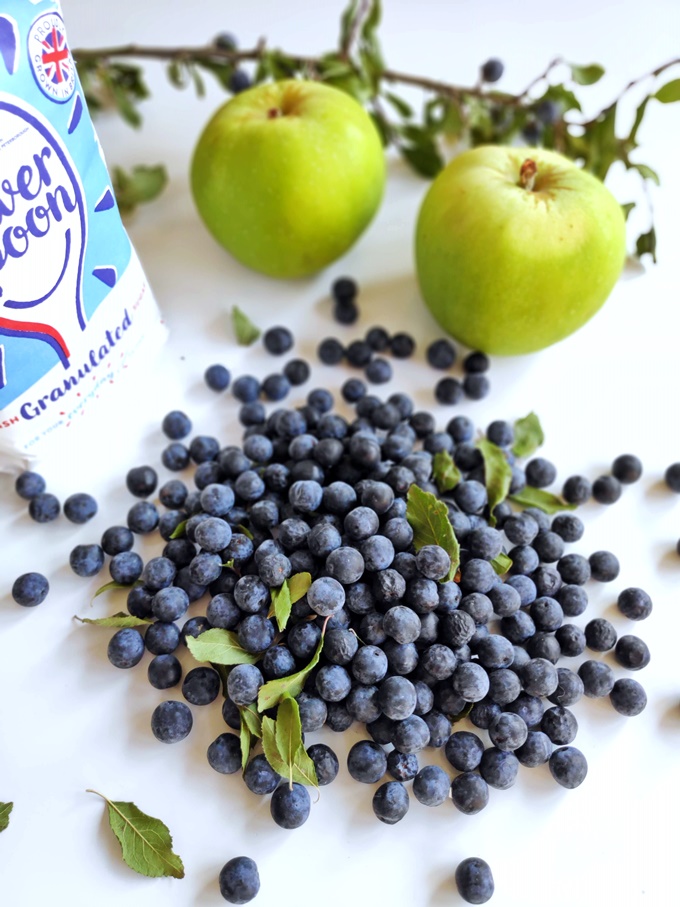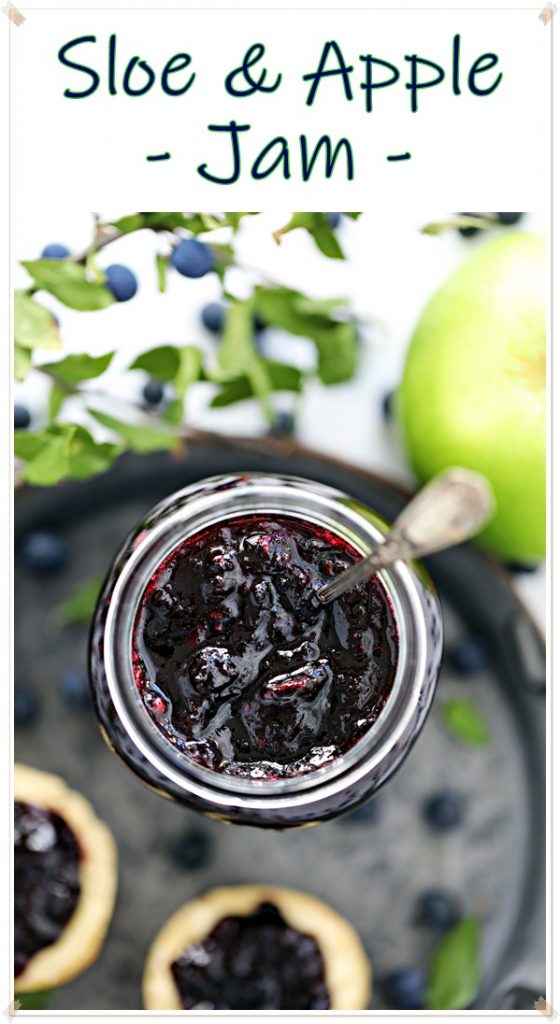
Recently I went foraging for elderberries to a location I’d been told about that also had sloes. I didn’t find any elderberries but did find the sloes so picked those instead. I popped them in my fridge for a week until I had time to develop a hedgerow jam or sloe jam.

People tend to associate sloes with sloes gin, vodka or cordial but they make incredible jam when paired with another fruit or fruits. I chose apple for the pairing with my Plum & Apple Jam being the inspiration.

What does Sloe & Apple Jam taste like?
Sloe & Apple Jam has a beautifully unique flavour that is both tart and sweet and reminds me of gin! I delivered a jar to my parents the other day and you’ve never seen 2 more grateful people. They absolutely loved it! I enjoyed a slice of white buttered toast with it on while I was there and I have to say it is outstanding!

What are Sloes?
Sloes grow are dark purple/black drupes that grow on Blackthorn Trees (Prunus Spinosa) and appear between September to December (dates vary each season according to the weather). They are similar to Damsons but much smaller.
Sloes have a very astringent, tart taste so are no good for eating raw. You can literally feel your mouth dry out when you taste one!
Many people wait for the first frost before picking to help counteract this. I actually pitted mine and then put in the freezer. However, that was more of a time issue than anything else as pitting takes ages. But don’t let that put you off, the result will be worth it and menial tasks are so therapeutic especially if you share them!

Tips for foraging for Sloes
Sloes are aptly named as there is nothing fast about foraging for them. You’ll find them in hedgerows and sometimes in parks in towns and cities.
My best advice would be to wear long sleeves as the thorns on the blackthorn are long and nasty!
Plus keep both hands free for picking which will be quicker so bring a container or bag which you can fold down the sides of it so it stays open. That way you can just drop the berries as you pick.
If you aren’t sure where to find sloes try doing a shout out in a local Facebook group. You’ll probably find people want to direct message you rather than tell everyone!

How do you pit sloes?

These are my 2 pitting hacks for sloes:
- When I was faced with my Damson pitting dilemma (for my Damson Jam) I worked out that a cherry pitter was perfect for the job. However, sloes are so small that they fall straight through a cherry pitter. “Invention is the mother of all necessity” as they say so I put my thinking cap on again!
It took me 24 hrs to come up with a solution after trying various lids from things I had in the fridge. Finally, I was using up the last of a tube of tomato puree and I had my light bulb moment! The steel top of a puree tube is the perfect size to sit sloes on and use to adapt a cherry pitter.
Just cut the metal top away from the tube with a small knife, file any rough edges and sit in a cherry pitter. Then pit in the usual way.
Only my cheap and basic cherry pitter worked for this. I wouldn’t advise cutting or bending the top to fit as you could end up with sharp corners and cut yourself. Safety first folks!
- The other way is the same as for damsons, you can just pinch the stone out between your thumb and index finger. This is also a great way to determine if your sloes are ripe!
I ended up using both methods, it’s a labour of love either way. I suggest getting your family to help or put on a really good film while you do it!

Do Sloes stain?
Yes, sloes stain badly. Wear an apron when you prepare them and keep them in your kitchen. I made the mistake of leaving the bowls and cherry pitter I’d used on the worktop overnight. The next day I had to use a metal scourer to remove the juice stains as it was like they were glued on.

Are Sloes high in pectin?
Yes, sloes are full of pectin just like the Bramley apples in this recipe are. Hence the time to reach setting point is about 4 minutes. The quickest setting time I’ve ever known!

What can Sloe & Apple Jam be used for?
After having this jam on white toast with lashings of butter at my parents’ house the other day I would say that it’s also divine on scones for afternoon tea etc.
Bake it into cakes and muffins, spread it in Victoria Sponge, swirl it into yogurt or cheesecake, and top your porridge. You’ll enjoy it however you use it!

More preserves using foraged fruits
- Simple Elderberry Jam
- Easy Blackberry & Apple Jam
- Easy Seedless Blackberry Jam
- Blackberry & Apple Jelly
- Rosehip & Apple Jelly
- Easy Crab Apple Jelly
- Easy Blackberry Curd
- Hedgerow Jelly
- Hedgerow Vodka
- Sloe Cordial

I’m sure you’ll love my Sloe & Apple Jam so do tag @FabFood4All on social media if you make it and don’t’ forget to leave a comment below. I love hearing from you!
Pin for later!

Sloe & Apple Jam
Ingredients
- 500 g ripe sloes pitted (see pitting hacks in post)
- 500 g Bramley cooking Apples
- 1 kg granulated sugar
- 400 ml water
- Optional:
- 10 g unsalted butter or coconut oil to remove scum
Instructions
- Prepare your sloes by picking over for any leaves or bad fruit, rinse and pit (you can squeeze the stones out between your thumb and index finger or see my other pitting hack in post to adapt a cherry pitter).
- Peel, core and quarter the apples, then cut into small chunks (about the size of a raspberry).
- Place the pitted sloes and apple chunks into a preserving pan or similar with 200 ml of water.
- Bring to a boil and then simmer under a lid for 20 minutes (until apple is tender), stirring occasionally with a wooden spoon.
- At the same time place the sloe stones in a small pan with 200 ml of water, bring to the boil and simmer under a lid for 20 minutes, stirring occasionally.
- Once the sloe stones have cooked, place in a sieve over the cooked apples and sloes and push the flesh through with the back of a spoon.
- On a really low heat stir in the sugar and carry on stirring until it has completely dissolved (do not simmer). (Dragging your spoon across the pan there should be no crunching sounds).
- Then turn the heat up high and bring to a rolling boil and time for 3 - 4 minutes once it starts, stirring frequently to prevent the jam sticking to the pan.
- Take off the heat and test a few drops of jam on a chilled saucer and place in the fridge for a minute.
- Then run a finger through it, it should form crinkles, be tacky and not run back to the void your finger has just created. My jam was ready at 4 minutes as sloes and Bramley apples are both very high in pectin) so don’t over boil or you’ll get concrete.
- If your jam hasn’t reached setting point then boil for another minute and repeat the test until ready.
- Stir the jam vigorously to remove any scum but if that doesn’t work you can add a knob of butter or coconut oil for a vegan friendly option.
- Pot up into sterilised jars, a ladle and jam funnel are really useful here. I got just under 3 large 500 ml jars.
- Place lids on immediately and allow to cool.
- Store in a cool dark place and once opened store in the fridge and eat within a few months. Homemade jam is best eaten in the first year but will be shelf stable for many years.
Video
Notes
- Place 2 - 3 saucers/small plates in the freezer.
- Sterilise jars by washing in hot soapy water (or take straight from dishwasher), fill with boiling water, empty and then place in oven for 20 minutes at 140°C where you leave them until the jam is ready. Washed lids should be sterilised with boiling water and then left to drain (if still wet place in oven once you’ve turned the heat off and run with just the fan for a few minutes).






Helen
I’ve just made this and I think I’ve made a mistake 🙁 Are you putting the water from the boiled stones in with the fruit? I did, I used less than half of the stones as I had chucked most before I realised you need to boil them. although the jam tastes nice initially is has a bitter aftertaste.
Camilla
Hi Helen, not you didn’t make a mistake, you do sieve the stones along with the water to get out remaining flesh. This is a tart/sweet jam.
Camilla
I’ve been thinking more about your saying the jam was bitter, it shouldn’t be bitter. I’m guessing your sloes weren’t ripe as they usually ripen late autumn and at their best after first frost. But seasons don’t follow rules, even if most of your sloes were ripe and you had a few hard, unripe sloes in there it would be enough to turn the jam bitter.
Alexandra
Planning on making this jam later this week. My question is, my sloes are in the freezer but I didn’t pit them. Do you think I could just use them with the stones in and then sieve the finished jam to get them out? Thanks
Camilla
Yes that sounds sensible, you’d want to cook them separately from the apple to save time and effort. Alternatively leave the stones in and remove when serving the jam or you may be able to fish them out while the sloes are cooking.
Alexandra
Thank you for your reply! It never even occured to me to cook the sloes separate from the apples, so I’m really glad I asked you! I’m planning to make jam on Thursday, I’ll let you know how I got on and how we like it!
Camilla
Excellent Alexandra, just didn’t want you adding to your job:-) Look forward to hearing how you get on.
Elizabeth
Made this today and it tastes yummy.
Thank you.
Camilla
Excellent Elizabeth, so glad you like it:-)